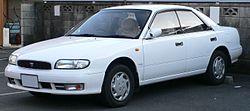- Nissan Bluebird (U13)
-
- This article incorporates information from the equivalent article on the Japanese Wikipedia.
Main article: Nissan BluebirdNissan Bluebird U13 
Production 1991–1997 Predecessor Nissan Bluebird U12 Successor Nissan Bluebird U14 Body style 4-door sedan
4-door hardtopLayout FF layout Engine 1.6 L-DOHC-I4 (GA16DS), 97 PS
1.8 L-DOHC-I4 (SR18DE), 125 PS
2.0 L-DOHC-I4 (SR20DE), 145 PS
2.0 L DOHC Turbo-I4 (SR20DET), 210 PS
2.0 L OHC Diesel-I4, 76 PSTransmission 5 speed manual transmission
4 speed automaticWheelbase 103.2 in (2620 mm) Length 180.5 in (4585 mm) Width 66.7 in (1695 mm) Height 55.3 in (1405 mm) Curb weight 2365-3025 lb (1070-1370 kg) Related Nissan Altima U13 The U13 series was launched in Japan in September 1991 as a four-door sedan and four-door hardtop. The two models were visually distinct: the four-door sedan had curves where its U12 predecessor had edges, while the hardtop, called the Nissan Bluebird ARX, had more traditional styling. The Bluebird wagon was replaced by the new Nissan Avenir.
Several Japanese models included an All Wheel Drive version (ATTESA).
The Australian delivered U13 Bluebird was released in late 1993 and terminated in 1997. Series 1 ran from 1993 until 1995 while Series 2 ran from 1995 to 1997. Series 2 saw the addition of a driver's airbag, revised grille styling, and a seat belt warning light. The Series 1 LX model came equipped with cruise control standard but strangely it was an option on the Series 2.
The Australian U13 Bluebirds were available in three different models, LX—the base model but very well equipped, Ti— the luxury model, and the SSS—the sports model. The U13 Bluebird was introduced in New Zealand during 1993, and was produced at Nissan's assembly plant in South Auckland until 1997, when it was replaced by the Primera. New Zealand models were; S (base model), SE (mid-spec), SES (sport) and SEL (luxury).
Compared to the LX, the Ti had climate control, a sunroof, woodgrain styling, and gear selector display on the instrument cluster (automatic models only). while comparing the LX to the SSS, the SSS had a HUD (heads-up display—digital speedo on windscreen), climate control, fog lights, ski-port, woodgrain styling, and gear selector display on the instrument cluster (automatic models only).
Despite there being a sports model (SSS), the LX was the fastest of the Australian models due to having the least weight.
The US-built U13 (Nissan Altima) was released in 1993 and was similar to the Australian U13.
The engine used in the Australian and US U13 models was the KA24DE (112 kW, 210 Nm of torque).
The engines used in the Japanese models ranged greatly in capacity and type. The SSS ATTESA LTD model used a redtop SR20DET (154 kW/206 hp). This was a similar engine/drivetrain package to the Pulsar GTi-R (169 kW). It had only a single throttle body as opposed the GTi-R multiple throttle body, smaller bearings, hydraulic rather than solid lifters, and a smaller turbo. The GTi-R had a large top mount intercooler, while the SSS ATTESA LTD had a smaller front mount intercooler. The Bluebird SSS was set apart from the North American Altima in that not only having the SR20DET and AWD ATTESA as an option, it also had power folding retracting mirrors (some heated) and a rear wiper if equipped with a spoiler.
EQ7200 series
Nissan Motor signed an agreement with Dongfeng Motor Co. of China, to build the Bluebird there in the early 2000s. It was the U13 model that was chosen, and is sold there as the Nissan Bluebird.
Yulon Motor, the Taiwan-based automaker, developed this variant of the U13, called the EQ7200-II series, in 2001. This featured a U13 central section but heavily revised front and rear ends. However, the centre of the car remains the same, and the 2,620 mm wheelbase is retained. No mention of the Taiwanese connection was made in advertising in mainland China.
The EQ7200-II was built until 2003, when it was replaced by a revised EQ7200-III model.
The car is considerably longer at 4,664 mm, as opposed to the original U13's 4,585 mm.
These Chinese models used a Chinese built SR20DE.
Categories:- Nissan vehicles
Wikimedia Foundation. 2010.


